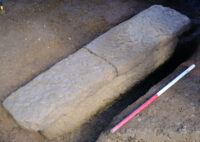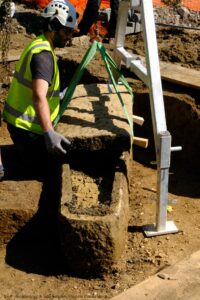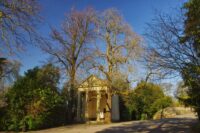 An ancient Roman stone sarcophagus containing the remains of two individuals has been discovered on the grounds of a Georgian pleasure garden in Bath. Archaeologists unearthed the intact coffin with lid at a site adjacent to a Roman wall on the edge of Bathwick Roman cemetery.
An ancient Roman stone sarcophagus containing the remains of two individuals has been discovered on the grounds of a Georgian pleasure garden in Bath. Archaeologists unearthed the intact coffin with lid at a site adjacent to a Roman wall on the edge of Bathwick Roman cemetery.
It is approximately 6.5 feet long and is made of native limestone. Inside was one complete skeleton in prone position with a partial one laid at its feet. The coffin’s north-south orientation marks it as a pre-Christian burial. A cremation burial, the first ever discovered at Bathwick, was found next to it, as was a small pottery vessel containing the remains of food, likely a votive offering, and some small red and blue glass beads.
Sylvia Warman, Science Advisor for Historic England has been providing advice about this rare find. Sylvia said: “This is an amazing find – although several Roman stone coffins have been found around Bath in the past, none have been excavated and recorded by professional archaeologists using modern methods until today. This is a first for Bathwick and a really significant find for Roman Bath and the World Heritage Site. When completed, a scientific study of the remains will likely tell us much more about the lives, death and burial practices of the inhabitants of Roman Bath.”
 Originally designed by Bath city architect Thomas Baldwin, Sydney Gardens was built in the 1790s, one of a plethora of Georgian commercial pleasure gardens built after the opening of London’s hugely popular Vauxhall Gardens in 1785. It opened in 1795 and offered paying visitors a variety of entertainment environments including a labyrinth, a bowling green, a Sham Castle with moat, a Cosmorama. It was instantly popular. Jane Austen lived at No. 4 Sydney Place when she lived in Bath between 1801 and 1804 and visited the gardens often. She wrote in her letters about enjoying its labyrinth, breakfasts, fireworks and the 15,000 lanterns that illuminated it at night.
Originally designed by Bath city architect Thomas Baldwin, Sydney Gardens was built in the 1790s, one of a plethora of Georgian commercial pleasure gardens built after the opening of London’s hugely popular Vauxhall Gardens in 1785. It opened in 1795 and offered paying visitors a variety of entertainment environments including a labyrinth, a bowling green, a Sham Castle with moat, a Cosmorama. It was instantly popular. Jane Austen lived at No. 4 Sydney Place when she lived in Bath between 1801 and 1804 and visited the gardens often. She wrote in her letters about enjoying its labyrinth, breakfasts, fireworks and the 15,000 lanterns that illuminated it at night.
The gardens were purchased by the city of Bath in 1908 and opened as a municipal park in 1913. It has been popular for concerts, picnics, lawn bowls ever since, but only a few of the original Georgian features have survived and they’re in need of conservation. Since February 2019, Sydney Gardens has been undergoing a revitalization program to restore the historic buildings, landscape and garden. It is expected to be complete in March 2022.
 One of the historic (but not original) buildings slated for restoration is Minerva’s Temple, a large garden shelter built of local limestone ashlar for the 1911 Festival of Empire at the Crystal Palace in London. It was a promotional structure, a replica of the Temple to Sulis Minerva found at the city’s iconic Roman Baths, serving as an advertisement for Bath stone. After some debate over the expense of moving it, the Temple was permanently installed in Sydney Gardens in 1913. It is now a Grade II listing building in its own right.
One of the historic (but not original) buildings slated for restoration is Minerva’s Temple, a large garden shelter built of local limestone ashlar for the 1911 Festival of Empire at the Crystal Palace in London. It was a promotional structure, a replica of the Temple to Sulis Minerva found at the city’s iconic Roman Baths, serving as an advertisement for Bath stone. After some debate over the expense of moving it, the Temple was permanently installed in Sydney Gardens in 1913. It is now a Grade II listing building in its own right.
Minerva’s Temple will house new information panels about the history of Sydney Gardens. The Bath City Council is considering installing the recently-discovered stone sarcophagus, emptied of its human remains, of course, in Minerva’s Temple for permanent display.